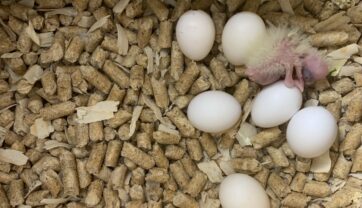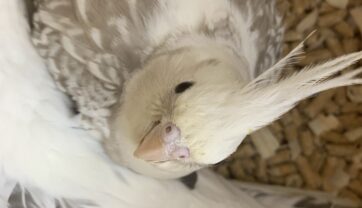Bronze Fallow Cockatiel
A bronze fallow cockatiel is a type of cockatiel. They are very popular because they can be trained to talk, sing and perform various tricks. The bronze fallow cockatiel has a very soft voice, which makes it fun to listen to. They are similar in appearance to a normal cockatiel, but they are a darker bronze color. If a bronze fallow cockatiel is kept in a cage, they will be happier, as they do not get as stressed out as other birds that are kept in cages.
Bronzed cockatiels (also known as bronze parakeets) were selectively bred in the 1960s by the famous breeder Alfred Chester. At the time, they were the only species of a cockatiel that could be artificially bred in a bronze color. The cockatiel’s bronze color is caused by a combination of genetic, nutritional, and environmental factors.
The bronze fallow cockatiel is a popular pet that can be found in many pet stores. They are easy to handle, intelligent, and friendly. But the bronze fallow cockatiel can also be a bit flighty, especially when they are together in a group. This is why it is best for the bronze fallow cockatiel to have their own space. Separate bedrooms for each cockatiel is a must-have for better overall health and happiness.
Mutation of bronze fallow cockatiel
Although they are a breed of parrot, the bronze fallow cockatiel is not a true cockatiel. It is one of the so-called captive mutations and is often misidentified as a cockatiel. These birds come in three color variations: bronze, green, and orange. Because of their color, these birds are also known as bronze cockatiels or simply bronze cockatoos. Cockatiels are some of the most popular pets in the world, but they are also among the most sensitive. A common mutation of these birds produces an albino mutation, which is a true form of albinism. This means that their feathers are white, and their eyes are pink. Another common mutation, which is also a mutation of the melanin, produces a mutation of the melanin called bronze fallow. When this mutation occurs, the melanin leaves the feathers and moves to the bird’s skin.
Bird-breeders produce hybrid birds by cross-breeding two or more different breeds of cockerels, and the results can be amazing. Take the bronze fallow cockatiel, for example. This cockatoo is a cross between the bronze and silver fallow cockatiel species. The bronze fallow cockatiel has a bright bronze body, and the silver fallow cockatiel has a silver body.
The bronze fallow cockatiel is native to Australia, but you can buy these birds from pet stores as well as breed them. These birds are also called bronze pieds, bronze pates, orange pieds, and bronze pates. The bronze fallow cockatiel will have bright green eyes, pale blue cheeks, and a bronze body. Its head is rounded with a crest, and the tail is slightly forked. The bronze felling cockatiel is a mutation of the normal green or silver cockatiel. The bronze felling cockatiel has a dark bronze head and buff feathers, with a green and white patterned breast, which doesn’t give the appearance of coloration. The bronze felling cockatiel is a mutable breed, which means that the offspring of the parents produce the color pattern. The bronze felling cockatiel is a small breed.
How to take care of Bronze Fallow Cockatiel
Most birds love to nest to their hearts’ content. But in the wild, such places are few and far between. That’s why many birds, including the Bronze Fallow, have developed a particular fondness for the scattered bronze bells we have lying around the house and garden. Bronze Fallow Cockatiels are colorful, lively (but quiet), small birds bred in captivity. They are very playful but easily bored and will become quite destructive if left in their cage alone for too long. They are fun to keep as pets but need decent exercise for the best results. The Bronze Fallow Cockatiel is by far the most popular of the six cockatiel species. It makes a very attractive pet and is one of the best choices for a beginner. Although the Bronze Fallow Cockatiel has many cool looks, the breed is getting rarer and rarer as people like me buy them and sell them to other people.
Temperament of Bronze Fallow Cockatiel
Cockatiels are one of the most common pet parrots, and they make very good pets. They are not hard to look after, they are not noisy, and they are not aggressive. They are usually very friendly and make great pets to teach your children about the birds. They are also very intelligent birds and tend to be very empathetic, which helps them bond with their owners.
Temperament of Bronze Fallow Cockatiel is one of the most popular bird breeds; they are known and loved not only in their own country but also all over the world. They are an intelligent breed and have some unique characteristics that make them even more popular and interesting. The Bronze Fallow Cockatoo is a species of cockatoo native to the forests of New Guinea. They are fairly large birds and are also known as the Bronze Cockatoo. The Bronze Fallow Cockatoo is sexually dimorphic, meaning that males and females differ in size and that the females are larger than the males. The Bronze Fallow Cockatoo’s head is black, and their irises are red. Their beak is mostly black, and their wings are black. Their tail is mostly green, yellow, and white, with bright yellow feet.
What food does of Bronze Fallow Cockatiel eats
Bronze Fallow Cockatiel eats a variety of fruits, veggies, and seeds but can also be fussy in regards to its food. It will eat most fruits such as apple, pear, grapes, grapes, mangoes, and berries, while it can also be habituated to eating vegetables such as lettuce, carrots, fighter, and broccoli. It will also eat seeds such as sunflower, flaxseed, pumpkin, and hempseed.
Taking care of Bronze Fallow Cockatiel
Cockatiels really do make a great pet. They are relatively inexpensive, they are great talkers, and they love being around people. The one disadvantage to owning a cockatiel is that they can easily get sick or have other health issues. Getting a cockatiel is a great way to learn a lot about bird care, but they need constant care to stay healthy.
A cockatiel is one of many varieties of parrots, which are small to medium-sized birds. Most cockatiels are brightly colored with blue, green, purple, or orange coloring. The cockatiel has been known to bond well with humans, and they are generally very intelligent birds, although they tend to bite if they feel threatened. Taking care of a pet can be expensive, so we have to make sure they get everything they need. From food and toys to grooming supplies, it seems like we need to buy everything a pet needs. But raising a pet is not a one-time expense. You will have to buy food, toys, and treats for your pet regularly. In addition, you will need to clean cages and bathe your pet.
Bronze Fallow Cockatiels are native to Australia and are very rarely imported. They are sometimes referred to as the Australian version of the cockatiel. They are very popular pets as they are small, intelligent, colorful, and friendly. However, they can be prone to skin problems and are often afraid of new faces. They are susceptible to stress when startled and require a lot of attention.
Size of The Bronze Fallow Cockatiel
The Bronze Fallow Cockatiel is a beautiful little parrot that originated in New Guinea. The name “Bronze Fallow” comes from the fact that the cockatiel’s feathers are dark bronze in color. The Bronze Fallow is fairly small, growing to about 17 inches in length and weighing between 3.5 and 5.5 pounds. The cockatiel is a very social bird and requires a large cage to fly and play properly.
The Bronze Fallow Cockatiel is a very popular pet if you are looking for a pet parrot. It can be small and very active, and commonly the bird is commonly bought for the pet parent because the pet parent is looking for a cute small parrot. The Bronze Fallow Cockatiel is a parrot that is commonly bought as a pet because of its cute small size. The Bronze Fallow Cockatiel is usually bought as a pet because they are very cute. The Bronze Fallow Cockatiel is a parrot that is very active, and they are not as suitable for having around children.


